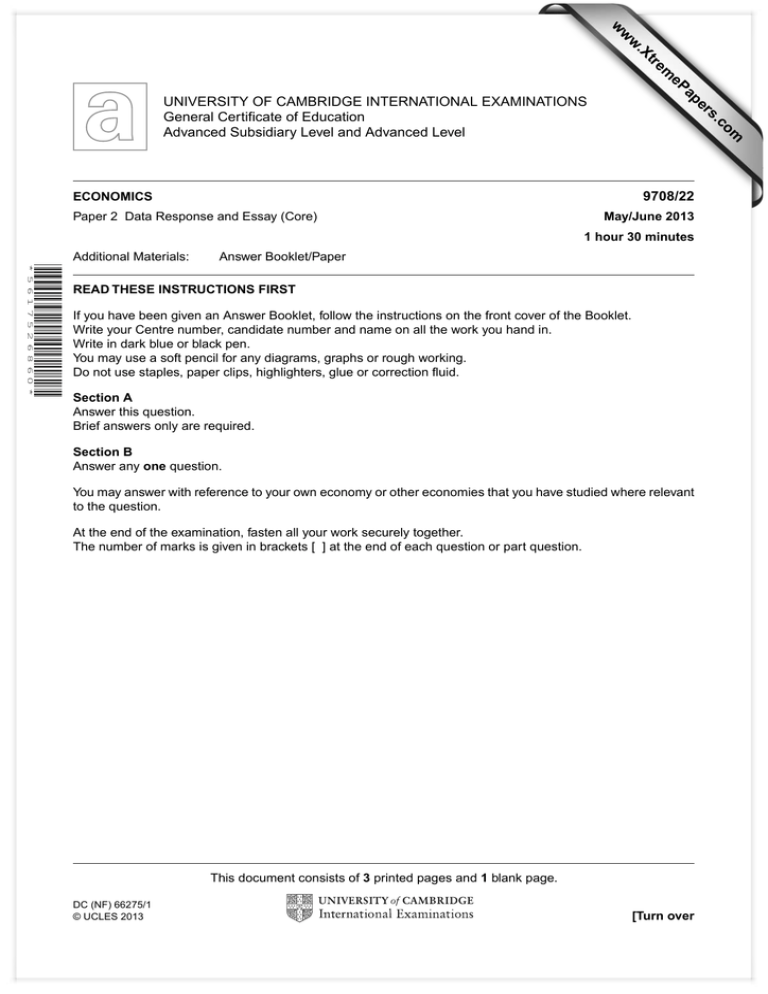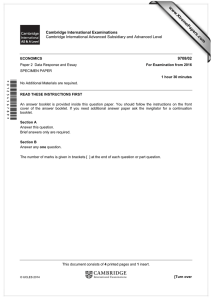www.XtremePapers.com
advertisement

w w ap eP m e tr .X w om .c s er UNIVERSITY OF CAMBRIDGE INTERNATIONAL EXAMINATIONS General Certificate of Education Advanced Subsidiary Level and Advanced Level 9708/22 ECONOMICS Paper 2 Data Response and Essay (Core) May/June 2013 1 hour 30 minutes Additional Materials: Answer Booklet/Paper * 5 6 1 7 5 2 6 8 6 0 * READ THESE INSTRUCTIONS FIRST If you have been given an Answer Booklet, follow the instructions on the front cover of the Booklet. Write your Centre number, candidate number and name on all the work you hand in. Write in dark blue or black pen. You may use a soft pencil for any diagrams, graphs or rough working. Do not use staples, paper clips, highlighters, glue or correction fluid. Section A Answer this question. Brief answers only are required. Section B Answer any one question. You may answer with reference to your own economy or other economies that you have studied where relevant to the question. At the end of the examination, fasten all your work securely together. The number of marks is given in brackets [ ] at the end of each question or part question. This document consists of 3 printed pages and 1 blank page. DC (NF) 66275/1 © UCLES 2013 [Turn over 2 Section A Answer this question. Palm Oil Production 1 Palm oil is used in the production of many goods, including cooking oil, margarine, ice cream, soap, shampoo and more recently fuel for vehicles. It competes with other vegetable oils, made from soyabeans, rapeseed, sunflowers and groundnuts. While palm oil production takes up 6% of the land used for vegetable oil plants across the world, it produces 38% of the total output of vegetable oil globally and accounts for 60% of world exports of vegetable oil. Palm oil is produced from the flesh of the palm fruit and, at the same time, palm kernel oil is produced from the kernel or seed. After the extraction of the oils the waste is turned into palm kernel cake that is then sold for animal feed. In Malaysia the palm oil industry employs 570 000 people of which 405 000 are engaged in cultivation. Malaysia and Indonesia are the world’s two most important palm oil producers and details of their production are given in Table 1. Table 1: Palm oil production in Malaysia and Indonesia, 1995 and 2008 Malaysia Indonesia 1995 Production (’000 tonnes) 7 811 4 480 1995 Area cultivated (’000 hectares) 2 540 2 025 17 734 18 090 4 488 7 008 2008 Production (’000 tonnes) 2008 Area cultivated (’000 hectares) The increase in the cultivation of palm oil has been criticised on environmental grounds. There have been accusations of deforestation, reduction of biodiversity, harm to wildlife and increasing emissions of greenhouse gases. One response has been an organisation of growers, processors, and food companies to encourage the production of sustainable palm oil that limits the harm to the environment. (a) Give two reasons why palm oil is an important product for the economy of Malaysia. [2] (b) Analyse, with the aid of diagrams, the impact of an increase in demand for palm oil on the markets for palm oil and palm kernel cake. [5] (c) (i) How can Table 1 be used to provide one measure of productivity in palm oil production? [2] (ii) Use Table 1 to compare the productivity of palm oil production in Indonesia in 1995 and 2008. [2] (d) What additional information would give a better understanding of changes in productivity in palm oil production in Indonesia? [3] (e) Discuss any two policies that governments might use to prevent harm to the environment from palm oil production. [6] © UCLES 2013 9708/22/M/J/13 3 Section B Answer one question. 2 In a free market price rations scarce goods. (a) Explain this statement and, with the help of a diagram, show how price rations scarce goods when there is an increase in the costs of production. [8] (b) Discuss whether preventing the price mechanism from working freely by using government price controls can ever be effective. [12] 3 (a) Define the components of aggregate demand and, with the help of a diagram, explain how an increase in spending in an economy might result in inflation. [8] (b) If an economy is experiencing inflation, discuss the view that its government should be more concerned about the external effects than its effects within the domestic economy. [12] 4 (a) Explain the meaning of the term ‘protection’ in the context of international trade and describe two methods of protection used by governments. [8] (b) Discuss, with examples, how international trade protection may affect consumers and producers in an economy and whether on balance protection can be justified. [12] © UCLES 2013 9708/22/M/J/13 4 BLANK PAGE Copyright Acknowledgements: Question 1 © World Growth; Palm Oil the Sustainable Oil; September 2009; www.worldgrowth.org; 8 March 2011. Permission to reproduce items where third-party owned material protected by copyright is included has been sought and cleared where possible. Every reasonable effort has been made by the publisher (UCLES) to trace copyright holders, but if any items requiring clearance have unwittingly been included, the publisher will be pleased to make amends at the earliest possible opportunity. University of Cambridge International Examinations is part of the Cambridge Assessment Group. Cambridge Assessment is the brand name of University of Cambridge Local Examinations Syndicate (UCLES), which is itself a department of the University of Cambridge. © UCLES 2013 9708/22/M/J/13




